Achievement of Curriculum for Excellence (CfE) Levels 2020-21
Results of the achievement of curriculum for excellence (CFE) levels 2020 to 2021.
This document is part of a collection
Chapter 4: Achievement of CfE Levels by pupil characteristics
- Female pupils outperform male pupils across all literacy organisers at all stages.
- Across all stages and organisers the proportion of pupils achieving the expected level was lower for pupils with an Additional Support Need than for those without. This was also true for pupils with English as an Additional Language.
- A higher percentage of pupils of Asian – Chinese ethnic background achieved the expected CfE levels in numeracy compared to pupils of other ethnic backgrounds.
- At P1, the percentage of pupils achieving the expected level for their stage was highest for pupils living in accessible rural areas. At P4 and P7, performance was highest for pupils from either large urban areas or accessible rural areas.
4.1 Achievement of CfE Levels by Sex
Compared to 2018/19 (See Table 3 in the supplementary tables) the proportion of pupils achieving the expected CfE levels in 2020/21 has fallen cross all stages and organisers for both males and females. The size of these reductions was broadly similar for males and females.
In 2020/21, females outperformed males across all literacy organisers at all stages. The biggest difference was in writing. This pattern has been consistent since 2016/17.
In 2020/21, females outperformed males in numeracy in P1 and P7; this pattern has been consistent since 2016/17. In P4 males and females had a similar performance.
The largest difference in performance in literacy among primary pupils in 2020/21 was in writing in P7 with females outperforming males by 14 percentage points. The smallest difference at primary for the literacy organisers was in reading for P1, where females outperformed males by six percentage points.
The gap in literacy performance by sex increases through the primary stages, with females outperforming males by 9, 11 and 13 percentage points for the P1, P4 and P7 stages respectively.
Across all stages the smallest difference in performance by sex was in numeracy. In 2020/21 females outperformed males in P1 and P7 in numeracy but by a smaller margin than for the other organisers; females outperformed males by two percentage points at P1 and by one percentage point at P7. Females and males have a similar performance at P4.
Chart 9 shows performance in literacy and numeracy by sex for each primary stage.
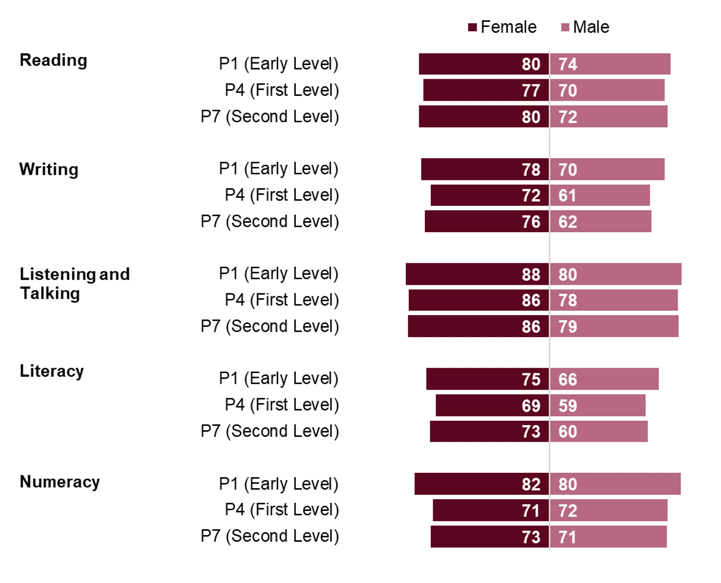
4.2 Achievement of CfE Levels by Ethnicity
For context, the majority of pupils in the Achievement of CfE Level data collection were White – Scottish (74 per cent of all pupils), followed by White – non-Scottish (13 per cent of all pupils). The remaining ethnic groups each made up two per cent or less of all pupils.
In 2020/21 the percentage of pupils achieving the expected CfE Level in literacy and numeracy has decreased across most ethnic groups compared to previous years, although the overall pattern of performance is similar to that reported in the 2018/19 results (see Table 4 in the supplementary tables).
Performance in numeracy was highest for pupils of an Asian – Chinese background. This pattern has been consistent since 2016/17. In 2020/21, 89 per cent of Asian – Chinese pupils achieved the expected level in both P4 and P7, rising to 91 per cent at P1.
Performance by ethnic group varies by stage. In P1 performance in literacy was highest for pupils from Mixed or multiple ethnic backgrounds, Asian – Indian and Asian – Chinese (all 78 per cent). In P4 pupils from Asian – Indian and Asian – Chinese backgrounds performed best (both 78 per cent) and in P7, pupils from Asian – Indian backgrounds performed best (80 per cent).
S3 figures are not available for 2020/21; for more information see Chapter 1.3
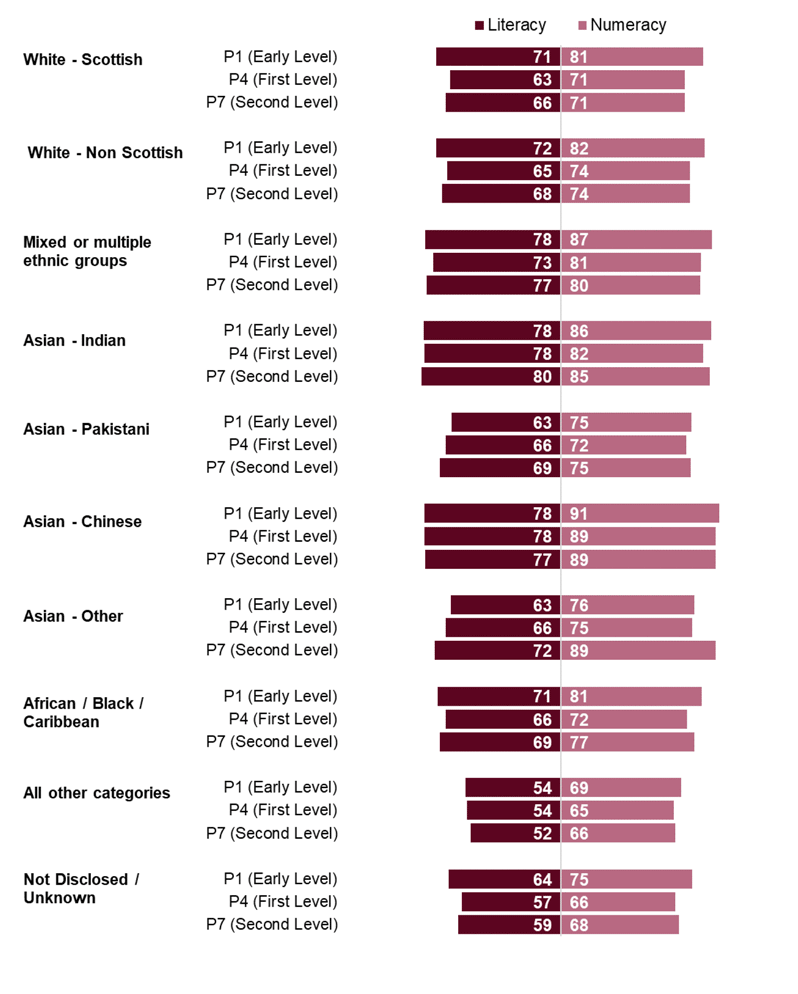
4.3 Achievement of CfE Levels by Additional Support Need (ASN) status
The following chapter provides information on the proportion of pupils with an Additional Support Need who achieved the expected CfE Levels. For context, 13 per cent of P1 pupils, 29 per cent of P4 pupils and 35 per cent of P7 pupils in the 2020/21 Achievement of CfE Levels data collection were recorded as having an Additional Support Need.
Chart 11 shows that the percentage of pupils achieving the expected CfE level was higher for pupils recorded as not having an Additional Support Need (ASN), compared to pupils with a recorded ASN, across all stages and organisers. Considering the four main organisers – reading, writing, listening & talking and numeracy - the difference in performance in P1 was lowest for numeracy (20 percentage points). In both P4 and P7 it was lowest for listening and talking (both 25 percentage points).
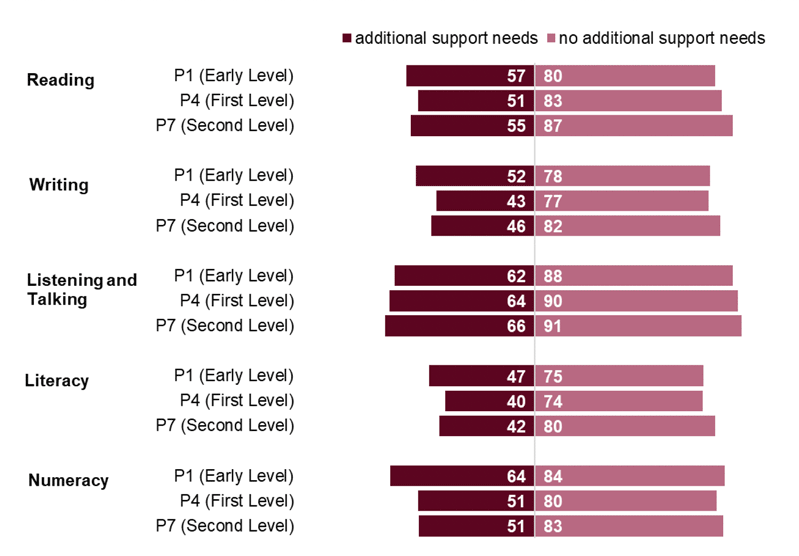
In P1 the greatest difference in performance in literacy organisers (between pupils with a recorded ASN and pupils with no recorded ASN) was in listening and talking (26 percentage points). At P4 and P7, the greatest differences in performance were in writing, with differences of 33 and 36 percentage points respectively.
Time series data (available in Table 6 in the supplementary tables) shows that the percentage of pupils achieving expected CfE levels in 2020/21 was lower than in 2018/19 across all stages and organisers both for pupils with a recorded ASN and for those without. The sizes of the reductions were broadly similar amongst both sets of pupils (i.e. those with a recorded ASN and those with no recorded ASN).
S3 figures are not available for 2020/21; for more information see Chapter 1.3
4.4 Achievement of CfE Levels by English as an Additional Language (EAL) status
For context, between five and eight per cent of pupils in P1, P4 and P7 in the 2020/21 Achievement of CfE Levels data collection were recorded as having English as an Additional Language (EAL).
The percentage of pupils achieving the expected CfE level was higher for pupils with English as their main language across all stages and organisers (Chart 12).
In 2020/21 the gap in performance between EAL pupils and pupils with English as their main language was lowest in numeracy; ranging from one percentage point for P4 and P7 pupils to five percentage points for P1 pupils.
EAL pupils performed better in listening and talking than in the other literacy organisers at all three primary stages (72, 77 and 75 per cent for P1, P4 and P7 respectively); the same pattern observed in the overall results for all pupils. However, the largest gap in performance between EAL and English as main language pupils in the literacy organisers was also in listening and talking (13 percentage points at P1).
The performance gaps in the literacy organisers were generally smallest at P4; ranging from four to six percentage points. In P1 there was a difference of eight to 13 percentage points and in P7, there was a difference of six to eight percentage points between EAL and English as main language pupils across the three literacy organisers.
In comparison to previous years, the proportions of pupils achieving the expected level in literacy and numeracy reduced for both pupils with English as their main language and for pupils with English as an Additional Language. However, the proportions reduced by more for pupils with English as their main language (See Table 7 in the supplementary tables).
S3 figures are not available for 2020/21; for more information see Chapter 1.3
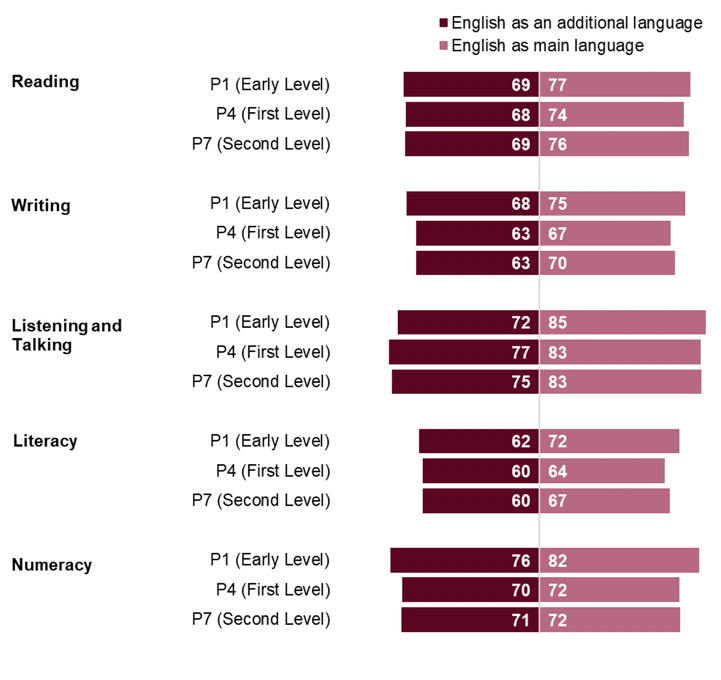
4.5 Achievement of CfE Levels by Urban Rural Classification
The Urban Rural Classification used in this publication has six classifications as shown in Table 2. The P1, P4 and P7 pupils in the achievement of CfE Levels 2020/21 data collection were distributed as follows:
| Urban Rural Classification | Percentage |
|---|---|
| Other urban areas | 37 |
| Large urban areas | 31 |
| Accessible rural areas | 14 |
| Accessible small towns | 9 |
| Remote rural areas | 5 |
| Remote small towns | 3 |
| Unknown | 1 |
Chart 13 shows a summary of the percentage of pupils achieving expected CfE levels in literacy and numeracy, by Urban Rural Classification and stage. Detailed results by Urban Rural Classification can be found in the supplementary tables.
At P1, performance was highest for pupils from accessible rural areas across numeracy and all literacy organisers. Performance was lowest for pupils from remote small towns for all organisers.
The areas with the highest performance for P4 and P7 pupils varied with organiser, and included large urban areas and accessible rural areas. Performance at P4 and P7 was lowest for pupils from remote small towns and remote rural areas across all organisers.
In 2020/21 the percentage of pupils achieving the expected CfE Levels in literacy and numeracy decreased across almost all urban rural categories compared to previous years. The overall pattern of performance is similar to that reported in the 2018/19 results (See Table 5 in the supplementary tables).
S3 figures are not available for 2020/21; for more information see Chapter 1.3
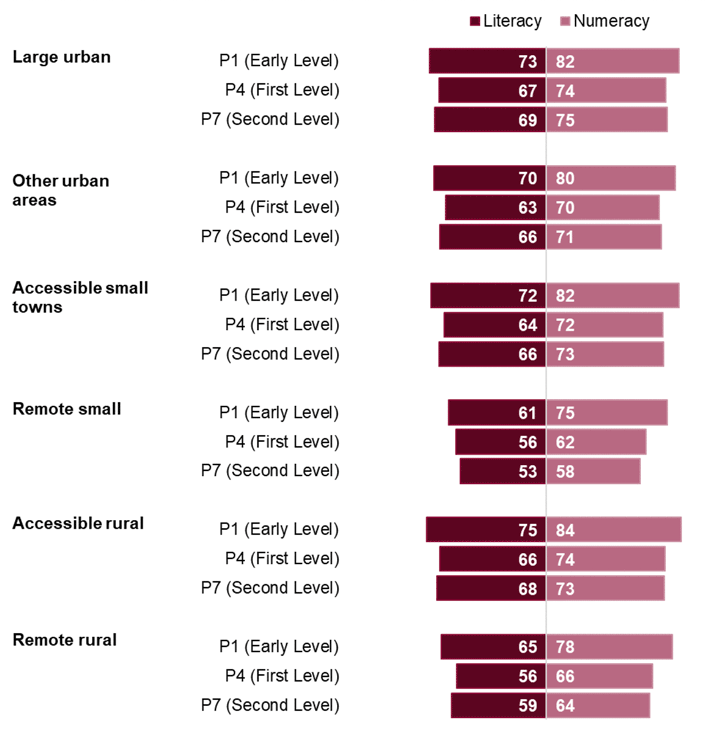
Note:
a. Scottish Government Urban Rural Classification 2016
Contact
Email: Andrew.White@gov.scot
There is a problem
Thanks for your feedback